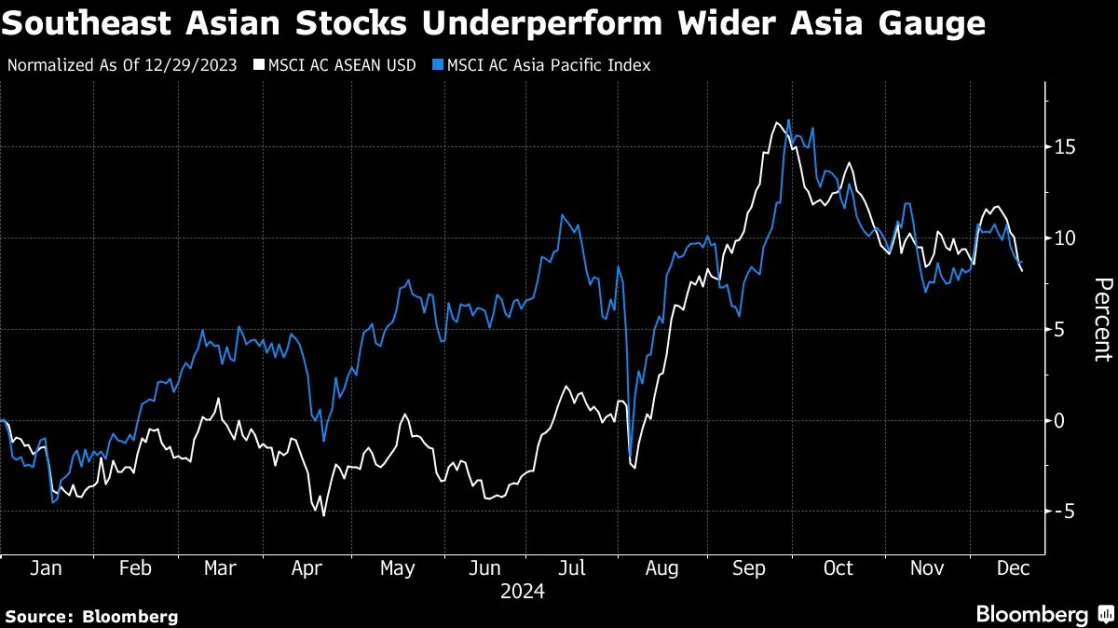(Bloomberg) -- Global investors are looking to Southeast Asia for some shelter as they brace for uncertainties surrounding Donald Trump’s trade policies, boosting prospects for the region’s stocks in the coming year.
The US president-elect’s targeted tariff plan for China is likely to accelerate a shift in global supply chains and foreign direct investment that may favor the region, analysts said. Meanwhile, economies with less trade exposure may fare better on growth, and domestic spending in some markets is anticipated to be robust.
While the regional benchmark MSCI Asean Index has slightly underperformed the wider Asia gauge this year, and most countries are seeing foreign outflows, funds are betting that investors will return next year. More investments into the region’s infrastructure and budding sectors, including data centers and green energy, will bode well for corporate profit growth.
“Domestically driven markets like Indonesia and the Philippines stand out for their relative stability, supported by strong consumption and policy flexibility,” making them well-positioned as stable options for investors, said Mohit Mirpuri, an analyst at SGMC Capital Pte.
The MSCI Asean gauge has gained 7.7% this year. The measure may rise as much as 14% to 780 by the end of 2025 from Wednesday’s close if a bullish scenario emerges, according to JPMorgan Chase & Co.’s estimates.
Global funds have sold stocks in Malaysia, Philippines, Thailand and Vietnam on a net basis this year. While the Federal Reserve cut benchmark interest rate for a third consecutive time, it signaled greater caution over how quickly it can continue reducing borrowing costs, which may affect flows.
But the outlook for foreign flows may gradually improve as the region will benefit “tremendously” from spillover effects of the US-China tension, said Vicki Chi, a portfolio manager for Asian equities at Robeco Hong Kong Ltd, who remains overweight on Asean markets.
Developing Asean banks, whose net interest margins are seen as more independent from global interest rate moves, and information technology-related shares are among Chi’s main picks.
While export-dependent countries may be more impacted by a trade war, ongoing policy reforms in Malaysia and strong government spending in Vietnam will likely help prop up growth. A recovery in tourism and strong domestic demand are expected to benefit Thailand.
In Singapore, high-yielding assets will keep investors interested.
“We have seen a lot of interest from Chinese companies trying to invest in Asean not solely to diversify manufacturing capacity exposure but also tapping into domestic demand,” said Kenglin Tan, a portfolio manager at Manulife Investment Management HK Ltd.
Valuations are also tilted in Southeast Asia’s favor. The MSCI gauge is trading at 13.5 times forward earnings, compared to the five-year average of 14.6 times.
To be clear, multiple headwinds remain. A slowdown in global demand will weigh on the region’s exports, while a stronger dollar due to any pause in the Federal Reserve’s easing policy will impact flows into emerging markets.
Still, growth for most countries is expected to be resilient, underscored by Maybank Research’s estimate that Asean gross domestic product will expand 4.7% next year.
“We urge investors to increase allocation to Asean,” said Nirgunan Tiruchelvam, head of consumer and internet at Singapore-based Aletheia Capital.
(Updates with Federal Reserve’s future interest-rate cuts in sixth paragraph)


